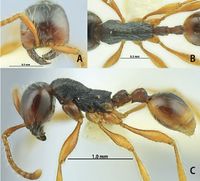Aenictus pinkaewi
| Aenictus pinkaewi | |
|---|---|

| |
| Scientific classification | |
| Kingdom: | Animalia |
| Phylum: | Arthropoda |
| Class: | Insecta |
| Order: | Hymenoptera |
| Family: | Formicidae |
| Subfamily: | Dorylinae |
| Genus: | Aenictus |
| Species: | A. pinkaewi |
| Binomial name | |
| Aenictus pinkaewi Jaitrong & Yamane, 2013 | |
So far this species is known only from highlands. Workers carry out their raids and immigrations on the ground surface in highly varied situations from open areas, secondary forest to deep forest interiors during the day and night. The type series was collected by pitfall traps in a secondary forest. W. Jaitrong observed this species preying on ants of the genus Pheidole. (Jaitrong and Yamane 2013)
Identification
A member of the ceylonicus group. Jaitrong and Yamane (2013) - Aenictus pinkaewi is similar to Aenictus fuchuanensis, Aenictus maneerati, and Aenictus sundalandensis in having the long cylindrical petiole and short head (CI 100-112). It is most similar to A. fuchuanensis.
Keys including this Species
Distribution
Distribution based on Regional Taxon Lists
Oriental Region: Thailand (type locality).
Distribution based on AntMaps
Distribution based on AntWeb specimens
Check data from AntWeb
Countries Occupied
| Number of countries occupied by this species based on AntWiki Regional Taxon Lists. In general, fewer countries occupied indicates a narrower range, while more countries indicates a more widespread species. |

|
Estimated Abundance
| Relative abundance based on number of AntMaps records per species (this species within the purple bar). Fewer records (to the left) indicates a less abundant/encountered species while more records (to the right) indicates more abundant/encountered species. |

|
Biology
Castes
Known only from the worker caste.
Nomenclature
The following information is derived from Barry Bolton's Online Catalogue of the Ants of the World.
- pinkaewi. Aenictus pinkaewi Jaitrong & Yamane, 2013: 207, fig. 16A-C (w.) THAILAND.
- Type-material: holotype worker, 40 paratype workers.
- Type-locality: holotype Thailand: Chiang Mai Prov., Muang Dist., nr Chiang Mai University, vi.2000, WJT00-CM01 (W. Jaitrong); paratypes with same data.
- Type-depositories: TNHM (holotype); BMNH, MCZC, SKYC, TNHM (paratypes).
- Status as species: Khachonpisitsak, et al. 2020: 31.
- Distribution: Thailand.
Unless otherwise noted the text for the remainder of this section is reported from the publication that includes the original description.
Description
Worker
(holotype and paratypes, n = 10). TL 2.90–3.35 mm; HL 0.60–0.69 mm; HW 0.65–0.75 mm; SL 0.45–0.58 mm; ML 0.93–1.10 mm; PL 0.23–0.29mm; CI 105–109; SI 69–82.
Head in full-face view subrectangular, slightly shorter than broad, sides feebly convex, and posterior margin feebly concave. Antennal scape reaching 2/3 of head length; antennal segments II-VI each distinctly longer than broad, of approximately same length; terminal segment (X) slightly longer than VII+VIII+IX. Frontal carina short, reaching the level of posterior margin of torulus. Parafrontal ridge absent. Anterior clypeal margin almost straight or feebly concave, lacking denticles, concealed by curved anterior extension of frontal carina. Masticatory margin of mandible with 4 teeth including a large apical tooth; basal margin feebly concave, lacking denticles. Maximum width of gap between anterior clypeal margin and mandibles about 1.9 times as broad as maximum width of mandible. Promesonotum strongly convex dorsally and sloping gradually to metanotal groove; metanotal groove indistinct; mesopleuron demarcated from metapleuron by a shallow groove; metapleural gland bulla relatively small, its maximum diameter about 1.6 times as long as distance between propodeal spiracle and metapleural gland bulla. Propodeum in profile with almost straight dorsal outline; propodeal junction angulate, overhanging the declivitous face of propodeum; the declivity broadly and shallowly concave, encircled with a rim. Petiole cylindrical, distinctly longer than high, with its dorsal outline slightly elevated posteriorly; posterior face of petiole shallowly concave, and encircled with a thin carina; subpetiolar process generally very low, with its anteroventral corner acutely angulate, and ventral outline feebly convex. Postpetiole almost as long as petiole, node convex dorsally and elevated posteriorly.
Head and gaster entirely smooth and shiny. Mandible very finely striate. Antennal scape superficially microreticulate, but shiny. Promesonotum entirely punctate; mesopleuron, metapleuron and propodeum punctate; in addition, upper portion of mesopleuron, upper portion of metapleuron, and lateral face of propodeum with longitudinal rugae. Petiole and postpetiole densely reticulate. Legs entirely smooth and shiny except basal portion of femora densely micropunctate.
Head and mesosoma dorsally with relatively dense standing hairs mixed with sparse short decumbent hairs; longest pronotal hair 0.23–0.25 mm long. Head including antennal scape and mandible, petiole and postpetiole dark reddish brown; mesosoma dark brown; gaster dark reddish brown; tip and lateral face of gaster, and legs yellowish brown.
Type Material
Holotype. THAILAND: Worker from N. Thailand, Chiang Mai Prov., Muang Dist., near Chiang Mai University, VI.2000, leg. W. Jaitrong, WJT00-CM01 (THNHM). Paratypes. Forty workers, same data as holotype (BMNH, MCZC, SKYC, THNHM).
Etymology
The specific name is dedicated to Dr. Nantasak Pinkaew of Kasetsart University, who helped us during our field works in Thailand.
References
- Dhadwal, T., Bharti, H. 2023. Aenictus dirangensis sp. nov. (Hymenoptera: Formicidae), a new species of Aenictus ceylonicus group from India. Journal of the Entomological Research Society 25(2): 387-403 (doi:10.51963/jers.v25i2.2367).
- Jaitrong, W. & Yamane, S. 2013. The Aenictus ceylonicus species group (Hymenoptera, Formicidae, Aenictinae) from Southeast Asia. Journal of Hymenoptera Research 31:165-233.
- Khachonpisitsak, S., Yamane, S., Sriwichai, P., Jaitrong, W. 2020. An updated checklist of the ants of Thailand (Hymenoptera, Formicidae). ZooKeys 998, 1–182 (doi:10.3897/zookeys.998.54902).
References based on Global Ant Biodiversity Informatics
- Borowiec M. L. 2016. Generic revision of the ant subfamily Dorylinae (Hymenoptera, Formicidae). ZooKeys 608: 1–280.
- Jaitrong W. 2015. A revision of the Thai species of the ant genus Aenictus Shuckard, 1840 (Hymenoptera: Formicidae: Dorylinae). The Thailand Natural History Museum Journal 9(1): 1-94.
- Jaitrong W., and S. Yamane. 2013. The Aenictus ceylonicus species group (Hymenoptera, Formicidae, Aenictinae) from Southeast Asia. Journal of Hymenoptera Research 31: 165-233.